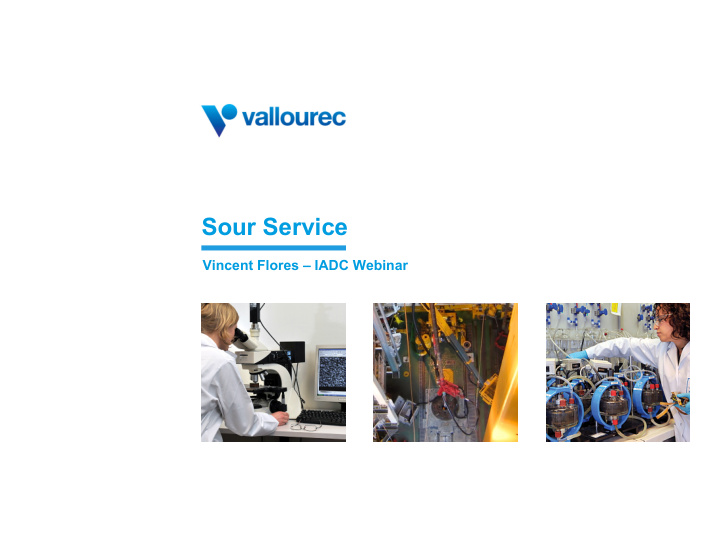



Sour Service Vincent Flores – IADC Webinar
Sour Service Environment § What is Sour Service? — Sour Service: Well containing H 2 S — Origin: H 2 S comes from decomposition of organic material. § Consequences? — HSE Risk & Environmental Impact concerns: hazardous to human health, living organisms and environment. Our challenge: Minimize risks — NPT & OPEX: • Loss of DP and/or BHA due to Sulfide Stress Cracking (SSC) • Fishing job required in case of failure • Non Productive Time in case of loss of well control / 2
Risks Associated to Sour Service Risks on standard API grades (= non Sour Service grade): § Sulfide Stress Cracking à Unpredictable brittle failure à Fishing costs à Non-productive time for drilling contractors § Failure example on 5 ” DP, S-135 API grade Failure example / 3
Drilling Challenges Catastrophic § Failure mechanism: Failure Sulfide Stress Cracking (SSC) Low pH Water ⇒ Corrosion High H 2 S ⇓ H Charging Low temperature Applied load § Escalation factors: ì • When Yield strength ì • Grade H 2 S resistance • SSC phenomenon occurrence ì • Failure risks / 4
NACE Testing Methods NACE TM 0177 (2005) defines 4 testing methods § Method A is the most used for drilling products § Solution A is the most used environment (Severe Sour environment) Acceptance Criteria: PASS FAIL NACE A NACE “Tensile Test” under uniaxial tensile load. § Failure/no failure test § Test duration: 720h / 5
NACE Testing Method A NACE Test A: Laboratory Procedure Environmental Testing Application of tensile load Example of samples Chamber = % SMYS under testing process Source: Vallourec Research Center / 6
Sour Service Severity Domains § NACE Material Recommendations: NACE MR0175 — 4 domains of susceptibility to H 2 S — pH and partial pressure of H 2 S as major parameters • Partial pressure = %H 2 S x total pressure 7 6,5 Domain 1: Mild Sour Service 6 Domain 2: Intermediate Sour Service 5,5 Domain 0: Non Sour Service 5 pH 4,5 Domain 3: 4 Severe Sour Service 3,5 3 0,0001 0,001 0,01 0,1 1 10 0,003 bar H 2 S partial pressure (bar) NACE Solution A conditions / 7
Material Selection for H 2 S resistant Drill Pipe § International standards: — No guideline in API 5DP & ISO11961 — Not included in the scope of the NACE MR0175 / ISO15156 § Industry initiatives: — Regional regulations: in Canada à Industry Recommended Practices (IRP) Volume 1 & 6 issued in 2004 (Vallourec produced its first IRP grade in 2007 for Sinopec) — Manufacturers: developing a variety of proprietary grades using NACE TM0177 testing since the 90’s — VNIIGAS qualification for Gazprom in Russia (Vallourec passed in 2009 and produced its order for Burgas-Gazprom in 2010) § A decade of IRP Drill Pipe use: — Worldwide supply: from one manufacturer in 2004 to > 5 in 2014 — Originated in Canada but used in several parts of the world, mainly: Russia, Middle East, China and Brazil — Successful switch from API to IRP products with safe operations
Evolution of the drilling environments & new frontiers § Pushing towards harsher drilling environments: — Due to increase of domestic gas demand, fields with higher and higher H 2 S content are being explored and developed — Managed Pressure Drilling & Underbalanced Drilling increase the risk of Drill Pipe exposure to fluids coming from the formation — HSE concerns is a first priority — Integrity of the entire Drill Pipe should now be considered § New frontiers: — Highly sour fields (higher H 2 S content). Example: Shah-24%, Bab-35% (UAE), SRAK-38% (KSA), Kurdistan-36% (Iraq) — HPHT conditions increasing the H 2 S partial pressure à SSC risk § Technological challenges: — SSC resistance in norms consider the pipe body and tool joint separatly and ignore the weld zone and upsets — The weld zone and upsets have metallurgical heterogeneities and often high hardness points, potentially detrimental to SSC — Even IRP 1.8 specification does not cover these areas
Sour Service Grades § Sour Service steel = material with resistance to H 2 S Steel Making Pipe Rolling Pipe Heat Treatment Pipe Finishing § Key processes control: Sour Service — Steelmaking: Grades • Supreme cleanliness = • Dedicated steel chemistries Specific — Heat treatment: Chemistry • Homogeneous and fine microstructure + • Specific heat treatments (double Q & T) Specific Heat — Welding: Treatment • Controlled hardness • Dedicated tempering / 10
Conclusion § Sour Service supplier of choice — Vertical integration of Vallourec mills — In-house R&D expertise and NACE testing facilities — Proven manufacturer of IRP 1.8 compliant products — Manufacturer of Sour Service BHA — Reliable quality products through more than 2,000,000 ft of Sour Service products used worldwide since 2007 without any failure! § Sour Service technical leader — On board of NACE committee and contributing to IRP & ISO standards — Yearly publications in international conferences — Industry recognized expertise in specialized workshops and technical conferences — Four new grades developed since the past 2 years, to address new frontiers and the extension of the drilling envelope 11
Recommend
More recommend